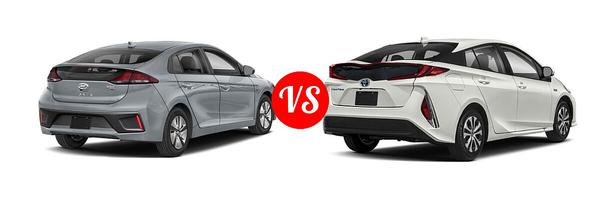The 2021 Toyota Prius Prime and the 2021 Hyundai Ioniq PHEV boast plenty of room for five and distinctive styling. Here’s how these plug-in hybrids compare.
2021 Toyota Prius Prime
2021 Toyota Prius Prime Starting Price: $28,220| Price Yours or View listings near you
Above Average: Total range up to 640 miles; Apple CarPlay, Amazon Alexa, and Android Auto integration; ample safety features; tax credit eligible.
Below Average: Polarizing design; smaller cargo space because of the battery; Android Auto only available on LE trim; lacks power.
Consensus: The Prius Prime is the plug-in version of the popular Toyota Prius. It gets a larger battery capacity and can travel up to 25 miles on electricity alone.
2021 Hyundai Ioniq PHEV
2021 Hyundai Ioniq PHEV Starting Price: $26,700| Price Yours or View listings near you
Above Average: Lifetime battery coverage; affordably priced; 29 miles of electric-only range.

Below Average: Lacks power.
Consensus: The 2021 Hyundai Ioniq PHEV is a great vehicle if you’re looking for something that doesn’t look like it was ripped out of the pages of a comic book. It comes packed with tons of safety and technology features and gets up to 29 miles of electric-only range.
Prime vs. Ioniq PHEV: Going the Distance
While the Prius Prime will cost you more than the regular Prius, it does come with some benefits. It’s still eligible for the federal tax credit and because it is so fuel-efficient you won’t be spending a ton on gas. While the exterior design is a bit more spaceship style and not for everyone, it definitely lets everyone know you are driving a hybrid. One major drawback: You can only get Android Auto on the LE trim, and not any higher trims.
On the road, the Prime is impressively comfortable with an uncanny ability to absorb bumps. You get Toyota’s suite of safety features called Toyota Safety Sense 2.0, which includes pre-collision alert with pedestrian and bicyclist detection, automatic emergency braking, full-speed radar cruise control, and lane-departure warning with steering assistance. The 2021 seats five passengers instead of four thanks to a 3-person bench in the back.
The 2021 Hyundai Ioniq lineup consists of three eco-friendly variants, each with its own drivetrains. Inside the body of a compact hatchback is either a hybrid, a more powerful plug-in hybrid (with a greater electric-only range than the regular hybrid, thanks to a bigger battery), or a fully electric system.
On the road, the plug-in hybrid gets up to 29 miles solely on electric power, after which it switches over to the gasoline hybrid system. While it costs a bit more than the Ioniq Hybrid, short commutes might not require any gasoline at all if you recharge every night. The only giveaway that you are driving a hybrid is some of the badging around the car. Unlike the Prius Prime, the Ioniq’s design doesn’t outwardly advertise that you are driving a hybrid vehicle.
Inside, the cabin is traditionally laid out and offers Apple CarPlay, Android Auto, and wireless phone charging. It also comes complete with Hyundai’s suite of safety features that includes forward-collision avoidance, lane-keeping assistance, adaptive cruise control, automatic high beams, and driver attention monitoring.
Tech and safety; federal tax credit eligibility; not particularly powerful.
Reliability; resale; hybrid fuel economy.
More affordable; more electric-only range; Android Auto available throughout the trims
Which One is Right for Me?
The Toyota Prius was one of the first hybrids, and adding the plug-in Prime further burnishes that reputation. It does offer striking styling and better hybrid fuel economy but falls a tad short in pure electric range.
The Hyundai Ioniq PHEV is more affordable, gets more electric-only range, and comes packed to the gills with technology. While the electric motor provides decent off-the-line acceleration, this vehicle is more about saving gas than performance.
Ready to buy a Toyota Prius Prime PHEV or Hyundai Ioniq PHEV? Shop for one on sale now near you.
| 2021 Toyota Prius Prime | 2021 Hyundai Ioniq PHEV |
| Popular Powertrains | | |
| Engine | 1.8-liter I4 PHEV | 1.6-liter I4 PHEV |
| Horsepower | 95 hp | 104 p |
| Torque | 105 lb-ft | 109 lb.ft. |
| Transmission | CVT automatic | 6-speed DCT automatic |
| Fuel Economy | 54 mpg combined (133 MPGe) | 52 mpg (119 MPGe) |
| EV-onlyRange | 25 miles | 29 miles |
| Specs | | |
| Warranty | 3 years/36,000 miles | Lifetime |
| Powertrain Warranty | 5 years/60,000 miles | 10 years/100.000 miles |
| NHTSA Safety Rating | 5 star | n/a |
| Max Seating Capacity | 5 | |
| Wheelbase | 106.3 inches | 106.3 inches |
| Overall Length | 180.0 inches | 175.9 inches |
| Width | 69.3 inches | 71.6 inches |
| Height | 58.1 inches | 57.0 inches |
| Turning Diameter | 33.5 feet | 34.76 feet |
| Headroom, Front | 39.4 inches | 39.1 inches |
| Headroom, Rear | 37.4 inches | 37.4 inches |
| Legroom, Front | 42.3 inches | 42.2 inches |
| Legroom, Rear | 33.4 inches | 44.7 inches |
| Shoulder Room, Front | 55.0 inches | 56.1 inches |
| Shoulder Room, Rear | 53.0 inches | 54.9 inches |
| EPA Passenger Volume | 91 cubic feet | 96.0 cubic feet |
| EPA Cargo Volume | 50.7 cubic feet | 23.0 cubic feet |




